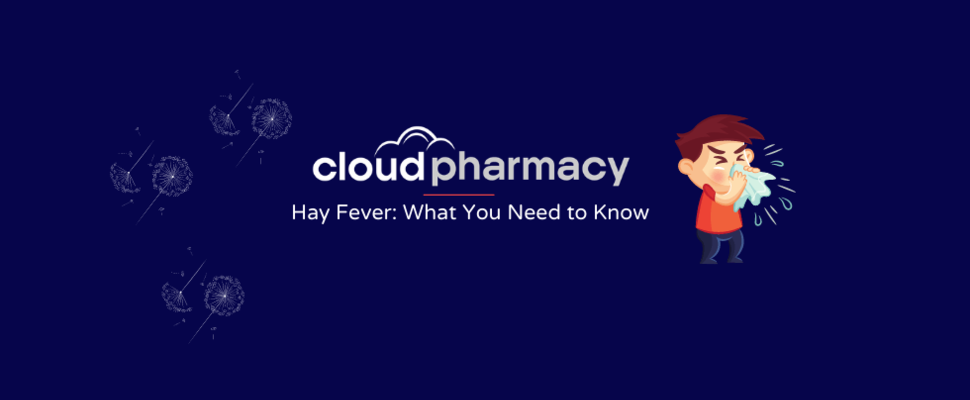What is Hay Fever?
The summer months are upon us- as is the onslaught of pollen, working it's way into every crack and crevice leading to a competitive sneezing, teary eyes and a runny nose. This week we talk about all things hay fever and what you can do to battle it.
What is Hay Fever?
Hay fever is a common allergic reaction which occurs at particular times of the year. It is known as seasonal rhinitis, sharing symptoms with perennial allergic rhinitis, but occurring as a reaction to pollen from grass, trees and weeds during the early spring and summer months. It can affect both adults and children.
What Causes Hay Fever?
When you have hay fever, your immune system identifies a harmless airborne substance as harmful. Your immune system then produces antibodies to this harmless substance such as pollen, house dust mites or mould, which are known as allergens. The next time you come in contact with the substance, these antibodies signal your immune system to release chemicals such as histamine into your bloodstream, which cause a reaction that leads to the signs and symptoms of hay fever.
Hay Fever Symptoms
Thankfully hay fever symptoms are not serious for us, although they are just a constant pain we need to experience during the warmer weather. Typical symptoms of hay fever include an itchy runny nose, sore throat, coughing, itchy red and watery eyes, tiredness, and earache. If you also suffer from asthma you may experience tightness of the chest and difficulty breathing.
How to Treat Hay Fever
Antihistamines are most commonly used by people who have allergic reactions to pollen and other allergens. They are also used to treat a variety of other conditions such as stomach problems, colds, anxiety and more. Antihistamines work by physically blocking the H1 receptors, stopping histamine from reaching its target. This decreases your body's reaction to allergens and therefore helps to reduce the troublesome symptoms associated with allergy.
Antihistamines can be split into two categories, ones that are drowsy and ones that are non drowsy. Typical antihistamines that make you feel sleepy are chlorphenamine, hydroxyzine, and promethazine. Non-drowsy antihistamines include cetirizine, loratadine, and fexofenadine.
With antihistamines, serious side effects are very unlikely - most of them are common side effects that go away on their own after a few days. Common side effects for antihistamines include:
- Sleepiness and reduced reaction speed and judgement
- Dry mouth
- Blurred Vision
- Difficulty peeing
If you are experiencing any life threatening symptoms like chest tightness, heavy breathing, or a very sudden sore head then please seek medical attention straight away.
How to Prevent Hay Fever
If we could prevent hay fever from happening we would, but sadly there is no cure for it 'nor is there a way to prevent it. We just have to sit and suffer and breathe through our only good working nostril until the season passes. Some things you can do to ease the suffering, particularly during high pollen counts, are as follows:
- Put Vaseline around your nostrils to trap pollen
- Wear wrap-around sun glasses to stop pollen getting into your eyes
- Shower and change your clothes after being outside, making sure to also wash your hair as pollen will get stuck in there too and make life hellish when you're trying to sleep
- Stay in-doors where possible
Equally, some things to avoid doing to help with the symptoms include:
- Do not cut grass or walk on grass
- Do not spend too much time outside
- Do not keep fresh flowers in house
- Do not smoke or be around smoke- it can exacerbate your symptoms
Can You Develop Hay Fever?
Whilst many of us assume that hay fever is something that develops in childhood, about one in five people with this condition develop symptoms for the first time when they're over 20. Allergies to tree nuts and peanuts tend to be persistent and are less likely to be outgrown. However, it is possible to develop allergies as adults – the late teens or 40+ are common times when adults will develop new allergies and this may be due to hormonal fluctuations. So just because you may have escaped your itchy and sweaty summers so far, that pollen may well come back and haunt you!
Hay Fever Season
There are around 30 types of pollen that could cause your hay fever. The pollen that causes hay fever can come from a number of sources, including:
- Grass Pollen – in the UK 90% of people with hay fever are allergic to grass pollen
- Tree Pollen – about 25% of people with hay fever in the UK are allergic to pollen from trees, including oak, ash, cedar and birch (people with an allergy to birch often also experience an allergic reaction to apples, peaches, plums and cherries because these types of fruit contain a similar protein to birch pollen)
- Weed Pollen– such as dock, mugwort and nettles; being allergic to weeds is less common and tends to occur during the autumn
It should be noted, that it is very much possible to be allergic to more than one type of pollen.
Different trees and plants produce their pollen at different times of the year. Depending on which type of pollen you're allergic to, you may experience hay fever symptoms at different times.
In the UK, the pollen count season is usually separated into 3 periods:
- Tree Pollen - late March to mid-May
- Grass Pollen - mid-May to July
- Weed Pollen - end of June to September
Hay Fever Pollen Count
The pollen count is measured according to the number of pollen grains per cubic metre of air. The predicted pollen release dates are based on information from pollen monitoring stations around the UK. If you suffer from hay fever it is important to monitor the pollen count, the higher the count the more likely the worse your hay fever will be that day.
The weather has a significant role in how much pollen is in production, distribution and dispersion. Rain, wind, temperature and sunshine all affect how much pollen will be produced and how. High pollen counts are also associated with thunderstorms and this weather is a risk factor for people with hay fever and asthma.
When pollen granules make contact with water, a reaction happens where small starch granules are released that are fine enough to be breathed into the nose and get deep down into the lungs, when this happens there is a risk triggering hay fever symptoms and asthma in some people.
















